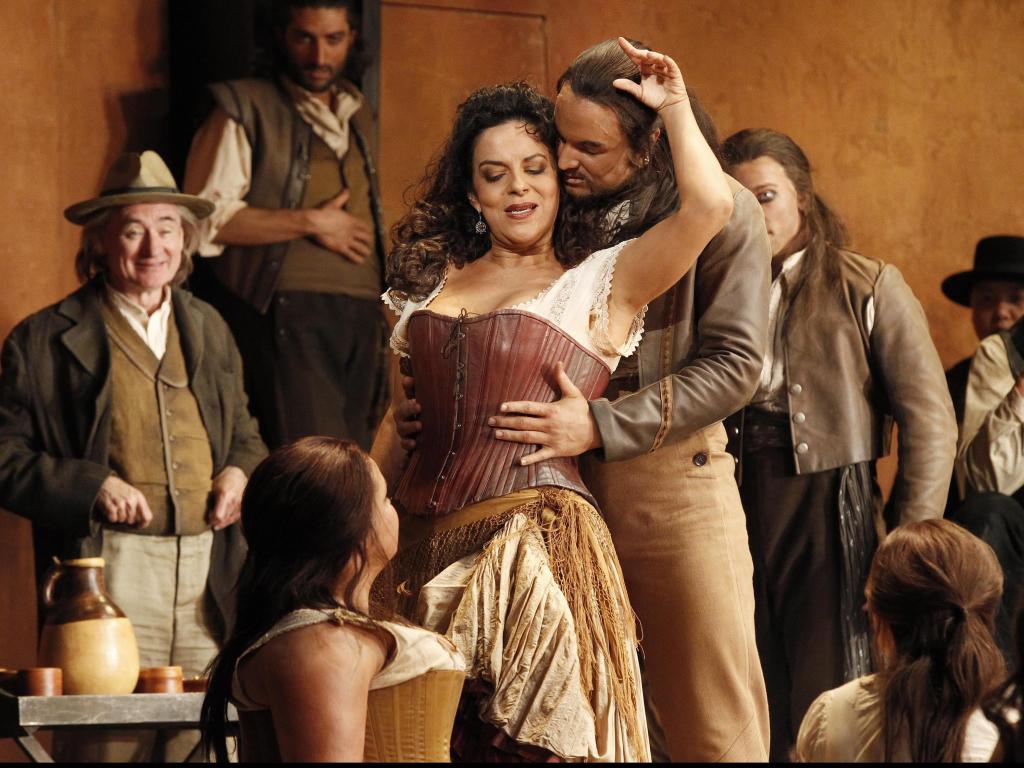Nancy Fabiola Herrera as Carmen. Image by Jeff Busby.
Bizet’s opera Carmen lends itself well to hype and this production from American director Francesca Zambello had no shortage of it. The central image for the publicity was of an exotic-looking female apparently in full control of a rearing horse at the end of a rope. There were indeed horses on stage at several points, although they appeared content to trot around with a rider on their back and one animal even demurely took a bow in best dressage style at the end of the opera.
But how did this story of the girl, the corporal and the toreador play itself out in this fairly conventional, if attractive, staging? Most importantly, how did the cast and principals acquit themselves particularly in some of the most popular arias in all opera? The short answer is: very well, for the most part. But the production deserves more attention than this.
For a start, opening night’s Carmen, Nancy Fabiola Herrera, was simply stunning and deserving of her international reputation as the quintessential Carmen. Herrera’s heroine was not just the feisty female of legend; she was the centre of the drama, relishing the action and attention, stamping her feet, tossing her hair and her skirts, demanding, provoking, teasing – and singing in a full-throated mezzo that grabbed the attention of not only her admirers, but the entire audience.
Carmen’s big number, Habanera (‘Love is a rebellious bird that nobody can tame’), reiterates the warning: ‘But if I love you, if I love you/Take guard of yourself!’ It serves as a summary for the action, which is essentially about sex and violence (usually centred around Carmen). In contrast to the time-bomb that is Carmen is Micaela, a girl from Don Jose’s village and his mother’s choice for his bride. Natalie Aroyan played and sang this role with strength and sweetness, acquitting herself particularly well in the Act 3 aria ‘Je dis que rien ne m’épouvante’ (sometimes known as Nocturne) in which she expresses her refusal to be frightened by Carmen.
Micaela’s duet with Don Jose (David Pomeroy) was also one of the best moments from the tenor. Pomeroy had some admirably strong upper notes but, like everyone else on stage, found himself in the shadow of the leading lady. This was also true of Escamillo (David Honeyman) although he did acquit himself well in the ‘Toreador Song’, to give the aria its popular title. However, Opera Australia presented a strong group of soloists and a chorus that could act convincingly as well as sing.
Thanks to revival director Matthew Barclay and his team, all were supported by an evocative (but not cliched) set, attractive costumes and choreography that worked. Best of all, under conductor Brian Castles-Onion they had the best possible support in Orchestra Victoria, which captured every nuance of Bizet’s score, and paid sympathetic heed to individual singers in arias that ranged from the evocative to the tempestuous.
Carmen
Arts Centre Melbourne, State Theatre, St Kilda Rd
www.opera.org.au
14 -25 May





